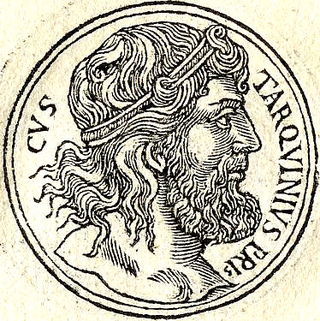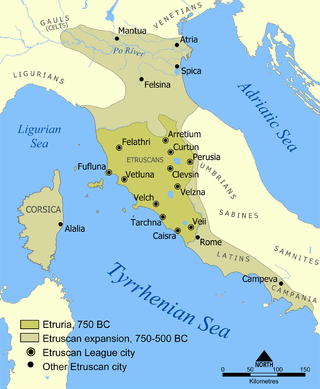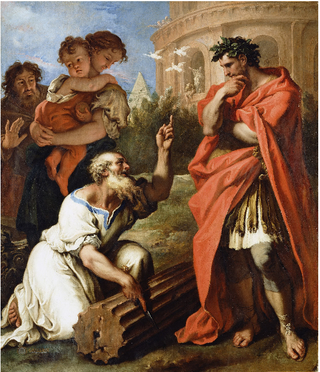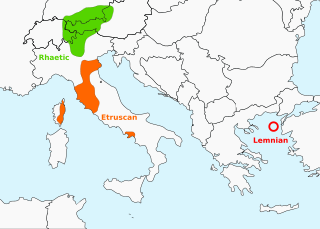Related Research Articles

Etruscan was the language of the Etruscan civilization in the ancient region of Etruria and its colonies in what is now Italy. Etruscan influenced Latin but was eventually completely superseded by it. The Etruscans left around 13,000 inscriptions that have been found so far, only a small minority of which are of significant length; some bilingual inscriptions with texts also in Latin, Greek, or Phoenician; and a few dozen purported loanwords. Attested from 700 BC to AD 50, the relation of Etruscan to other languages has been a source of long-running speculation and study, with it mostly being referred to as one of the Tyrsenian languages, at times as an isolate and a number of other less well-known theories.

Lydia was an Iron Age kingdom of western Asia Minor located generally east of ancient Ionia in the modern western Turkish provinces of Uşak, Manisa and inland Izmir. The ethnic group inhabiting this kingdom are known as the Lydians, and their language, known as Lydian, was a member of the Anatolian branch of the Indo-European language family. The capital of Lydia was Sardis.

Lucius Tarquinius Priscus, or Tarquin the Elder, was the legendary fifth king of Rome and first of its Etruscan dynasty. He reigned for thirty-eight years. Tarquinius expanded Roman power through military conquest and grand architectural constructions. His wife was the prophetess Tanaquil.

The Etruscan civilization was developed by a people of Etruria in ancient Italy with a common language and culture who formed a federation of city-states. After conquering adjacent lands, its territory covered, at its greatest extent, roughly what is now Tuscany, western Umbria, and northern Lazio, as well as what are now the Po Valley, Emilia-Romagna, south-eastern Lombardy, southern Veneto, and western Campania.

Etruria was a region of Central Italy delimited by the rivers Arno and Tiber, an area that covered what is now most of Tuscany, northern Lazio, and north-western Umbria.

Etruscan religion comprises a set of stories, beliefs, and religious practices of the Etruscan civilization, heavily influenced by the mythology of ancient Greece, and sharing similarities with concurrent Roman mythology and religion. As the Etruscan civilization was gradually assimilated into the Roman Republic from the 4th century BC, the Etruscan religion and mythology were partially incorporated into ancient Roman culture, following the Roman tendency to absorb some of the local gods and customs of conquered lands. The first attestations of an Etruscan religion can be traced back to the Villanovan culture.

Tages was claimed as a founding prophet of Etruscan religion who is known from reports by Latin authors of the late Roman Republic and Roman Empire. He revealed a cosmic view of divinity and correct methods of ascertaining divine will concerning events of public interest. Such divination was undertaken in Roman society by priestly officials called haruspices.
In Etruscan mythology, Tyrrhenus was one of the founders of the Etruscan League of twelve cities, along with his brother Tarchon. Herodotus describes him as the saviour of the Etruscans, because he led them from Lydia to Etruria; however this Lydian origin is to be debated as it contradicts cultural and linguistic evidence, as well as the view held by both the Etruscans themselves and by other Etrusco-Roman and Greek ancient sources. His name was given to the Etruscan people by the Greeks. The Romans extended this use to the sea west of Etruria: the Tyrrhenian Sea.

Falerii was a city in southern Etruria, 50 km northeast of Rome, 34 km from Veii and about 1.5 km west of the ancient Via Flaminia. It was the main city of the Falisci, a people whose language was Faliscan and was part of the Latino-Faliscan language group. The Ager Faliscus, which included the towns of Capena, Nepet, and Sutrium, was close to the Monti Cimini.

Tarquinia, formerly Corneto, is an old city in the province of Viterbo, Lazio, Central Italy, known chiefly for its ancient Etruscan tombs in the widespread necropoleis, or cemeteries, for which it was awarded UNESCO World Heritage status.

The gens Tarquinia was a plebeian family at ancient Rome, usually associated with Lucius Tarquinius Priscus and Lucius Tarquinius Superbus, the fifth and seventh Kings of Rome. Most of the Tarquinii who appear in history are connected in some way with this dynasty, but a few appear during the later Republic, and others from inscriptions, some dating as late as the fourth century AD.
Demaratus, frequently called Demaratus of Corinth, was the father of Lucius Tarquinius Priscus, the fifth King of Rome, and the grandfather or great-grandfather of Lucius Tarquinius Superbus, the seventh and last Roman king.

Tyrsenian, named after the Tyrrhenians, is a proposed extinct family of closely related ancient languages put forward by linguist Helmut Rix (1998), which consists of the Etruscan language of northern, central and south-western Italy, and eastern Corsica (France); the Rhaetic language of the Alps, named after the Rhaetian people; and the Lemnian language of the Aegean Sea. Camunic in northern Lombardy, between Etruscan and Rhaetic, may belong to the family as well, but evidence of such is limited. The Tyrsenian languages are generally considered Pre-Indo-European and Paleo-European.

The kings of Alba Longa, or Alban kings, were a series of legendary kings of Latium, who ruled from the ancient city of Alba Longa. In the mythic tradition of ancient Rome, they fill the 400-year gap between the settlement of Aeneas in Italy and the founding of the city of Rome by Romulus. It was this line of descent to which the Julii claimed kinship. The traditional line of the Alban kings ends with Numitor, the grandfather of Romulus and Remus. One later king, Gaius Cluilius, is mentioned by Roman historians, although his relation to the original line, if any, is unknown; and after his death, a few generations after the time of Romulus, the city was destroyed by Tullus Hostilius, the third King of Rome, and its population transferred to Alba's daughter city.
The Fanum Voltumnae was the chief sanctuary of the Etruscans; fanum means a sacred place, a much broader notion than a single temple. Numerous sources refer to a league of the "Twelve Peoples" (lucumonies) of Etruria, formed for religious purposes but evidently having some political functions. The Etruscan league of twelve city-states met annually at the Fanum, located in a place chosen as omphalos, the geographical and spiritual centre of the whole Etruscan nation. Each spring political and religious leaders from the cities would meet to discuss military campaigns and civic affairs and pray to their common gods. Chief amongst these was Voltumna, possibly state god of the Etruria.

Etruscan cities were a group of ancient settlements that shared a common Etruscan language and culture, even though they were independent city-states. They flourished over a large part of the northern half of Italy starting from the Iron Age, and in some cases reached a substantial level of wealth and power. They were eventually assimilated first by Italics in the south, then by Celts in the north and finally in Etruria itself by the growing Roman Republic.

Etruscan art was produced by the Etruscan civilization in central Italy between the 10th and 1st centuries BC. From around 750 BC it was heavily influenced by Greek art, which was imported by the Etruscans, but always retained distinct characteristics. Particularly strong in this tradition were figurative sculpture in terracotta, wall-painting and metalworking especially in bronze. Jewellery and engraved gems of high quality were produced.

In antiquity, several theses were elaborated on the origin of the Etruscans from the 5th century BC, when the Etruscan civilization had been already established for several centuries in its territories, that can be summarized into three main hypotheses. The first is the autochthonous development in situ out of the Villanovan culture, as claimed by the Greek historian Dionysius of Halicarnassus who described the Etruscans as indigenous people who had always lived in Etruria. The second is a migration from the Aegean sea, as claimed by two Greek historians: Herodotus, who described them as a group of immigrants from Lydia in Anatolia, and Hellanicus of Lesbos who claimed that the Tyrrhenians were the Pelasgians originally from Thessaly, Greece, who entered Italy at the head of the Adriatic sea in Northern Italy. The third hypotheses was reported by Livy and Pliny the Elder, and puts the Etruscans in the context of the Rhaetian people to the north and other populations living in the Alps. The first Greek author to mention the Etruscans, whom the Ancient Greeks called Tyrrhenians, was the 8th-century BC poet Hesiod, in his work, the Theogony. He mentioned them as residing in central Italy alongside the Latins. The 7th-century BC Homeric Hymn to Dionysus referred to them as pirates. Unlike later Greek authors, such as Herodotus and Hellanicus, these earlier Greek authors did not suggest that Etruscans had migrated to Italy from elsewhere.
Tarchon may refer to:
Vegoia is a sibyl, prophet, or nymph within the Etruscan religious framework who is identified as the author of parts of their large and complex set of sacred books, detailing the religiously correct methods of founding cities and shrines, draining fields, formulating laws and ordinances, measuring space and dividing time; she initiated the Etruscan people to the arts, as originating the rules and rituals of land marking, and as presiding over the observance, respect, and preservation of boundaries. Vegoia also is known as Vecu, Vecui, and Vecuvia, as well as Vegoe; her name is also given as Begoe or Bigois.
References
- ↑ Lydus, Joannes Laurentius. "2.6.B". De Ostentis.
- ↑ Dennis, George (2009) [1848]. Thayer, William (ed.). "Chapter XIX Tarquinii - The City". The Cities and Cemeteries of Etruria. London, Chicago: John Murray, University of Chicago. p. 372 Note 5. Retrieved 24 June 2009.
- ↑ Book VIII.506, 603; X.153, 290; XI.727, 746
- ↑ 5.2.2
- ↑ Bonfante, Giuliano; Bonfante, Larissa (2002). The Etruscan Language: an Introduction, Revised Edition. Manchester: University of Manchester Press. p. 219. ISBN 0-7190-5540-7.
- ↑ Green, Alberto R. W. (2003). The storm-god in the ancient Near East. Winona Lake, Ind.: Eisenbrauns. pp. 132–133. ISBN 1-57506-069-8.
- ↑ Golan, Ariel (1991). Prehistoric religion : mythology, symbolism. Jerusalem. pp. 75–76. ISBN 9659055501.
- ↑ De Simone, Carlo (1982). Tischler, Johann (ed.). Serta Indogermanica. Festschrift für Günter Neumann zum 60. Geburtstag (in German). Innsbruck: Institut für Sprachwissenschaft der Universität Innsbruck. pp. 401–402. ISBN 978-3851245684.
